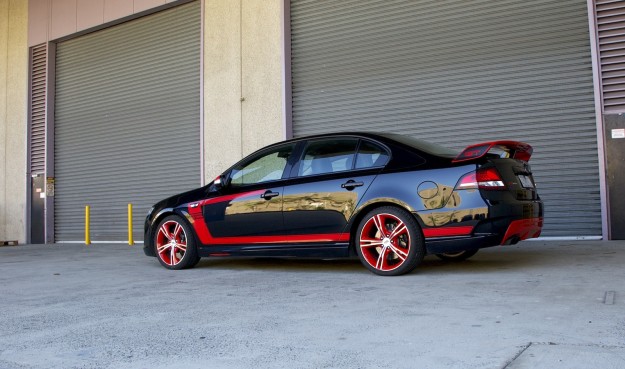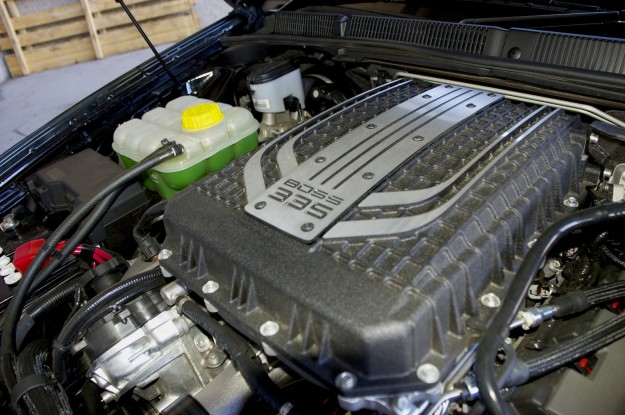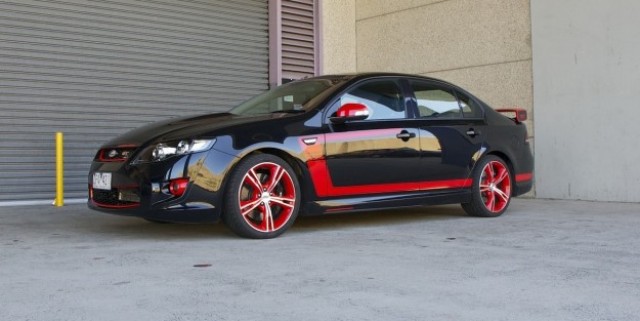The FPV GT RSPEC is the car Ford Performance Vehicles should have released when it introduced the supercharged Miami V8 in mid 2010.
It would be easy to assume this limited edition car is nothing more than a regular FPV GT Falcon with sticker kit and slightly wider tyres, but it is a very different animal. FPV has created an agile GT Falcon (at last) in the GT RSPEC which is far better able to make use of its monstrous power. Part of the reason this car is so different are the tyres, which are now one inch wider (nine inches) – 275/35 19-inch Dunlop Sports Maxx (FPVs says the 20s don't fit without a lot of work) – but the suspension changes are even more important. There is also the simple launch control system, all of which helps this Falcon set some pretty bloody good 0-100km/h times.
Before we get to the details, it should be noted that the name is ordinary. FPV GT RSPEC makes most people think of very fast Nissans. Surely they noticed should have worked this out. FPV engineers named it the Panther during the development process and we reckon that's what most people will call it. At this stage, the Panther is a limited run model, with only 350 to be made, but CarAdvice understands that if customers like it the car will probably be available in some form or another long term.

The FPV GT RSPEC costs $76,990, which is $6200 more than the regular GT, a lot of coin when it has some interior features that make it feel a bit old. Then again, well specified supercharged V8 performance sedans aren't particularly cheap.
Our test RSPEC is black with incredibly bright red highlights that mean you will never be missed on the street. Some of the people we ask during our drive love the look and others are horrified. Thankfully, there are a range of paint schemes that are not quite so bold (they are white, red or blue all with black accents).
The FPV GT RSPEC runs the same all-alloy 5.0-litre Miami V8 as the standard GT, which makes use of a Mustang Coyote engine from the US and adds a Harrop supercharger with Eaton lobes. The development of this V8 cost FPV around $35 million (it was hoping for an export deal that never happened) and the end result is a brilliantly-engineered performance V8. Officially, this engine makes 335kW and 570Nm of torque, which is a beautiful set of numbers, but the truth is that it makes more.
Thanks to a transient overboost function, the Miami produces about 375kW for around eight seconds at a time. Because it doesn't produce that amount all the time, it isn't counted in the official power figure. None of this really mattered before the Panther arrived, because most of the GTs power ended up being turned into tyre smoke anyway. The tyres were just too narrow.

Its soft suspension also made the big Ford a handful in corners and the combination of that softness and a huge amount of near-instant power made for a hairy experience. The standard GT still makes for a comfortable cruiser, which can blast away in a straight line, but it is too cumbersome for more spirited driving.
For the GT RSPEC, FPV reset the parameters for the chassis performance. It was given permission by Ford to develop this car within the same segment as the RS Focus and Boss Mustang, which meant they were allowed to compromise on ride quality to improve the handling.
The changes are noticeable from the get-go. The ride is now firm, probably about as hard as the RS Focus, and passes on most the imperfections of the road through to the cabin. Is it too firm? If you aren't an enthusiast then yes, it would be, but then there is always the regular GT.

The upside of the new suspension set-up is highlighted when you turn into a corner. While the regular GT feels ponderous as it leans over on the outside wheel and then responds to steering input, the GT RSPEC just turns. Indeed, the way it turns in is reminiscent of the Nissan 370Z.
FPV says this is because it changed the upper suspension mount and upper control arm bushes, making them 40 to 60 per cent stiffer. The monotube dampers were also given a firmer setting, a thicker anti-roll bar was installed, the rear lower control arm was reinforced and the toe setting was altered.
Now that there is less roll and the car turns in faster without drama, the front end giving the impression of being lighter even though it weighs the same as before. You start to hunt out corners, something you would not necessarily do in a regular GT. It really is a remarkable transformation. Those wider tyres help, too, transferring much more power to the road.
There's still a necessity to be smooth feeding on the throttle through a corner, because it will snap into oversteer, but the Panther is more likely to sling out of a bend right on the point of losing adhesion when the regular GT would have already started spinning its wheels rabidly.
We tested the FPV GT RSPEC on greasy roads that were moist for much of the time. Our test car was fitted with the German ZF-sourced six-speed automatic, which is a no-cost option and brings a surprising (contrasting) couthness to the FPV's character. It's certainly preferable to the heavy, notchy six-speed manual previously driven.
The launch control is standard with both transmission types. In the case of the manual, you press the clutch and hit the accelerator. After a couple of seconds, it brings the revs back to about 3200. In our automatic, you simply hold the brake and accelerator down together, then lift the left pedal. Then all hell breaks loose.
The only problem in our case was that it only worked once in every five times. An FPV engineer told me the system was developed primarily for dry smooth tarmac. It apparently works in full wet conditions, but not the slippery surfaces we were sitting on. The launch system is not as advanced as those fitted to sportscars running an automated clutch to get off the line, such as the Porsche dual clutch transmission that works every time all the time.
We hear the system worked well enough that FPV managed a 4.5 second 0-100km/h run on concrete, which was apparently backed by a car magazine running the same time at a drag strip.
Despite the challenging conditions, it is easy tell how fast this car is. The engine has instant punch and it doesn't relent, churning out incredible force all the way to the redline. It does this while also emitting a wonderful mix of thundering V8 exhaust and the shrill whine of a heaving supercharger. You will pay for the ferocious performance at the bowser. The official fuel consumption is 13.5 litres per 100km, but flog it like we did and the figure hits the higher teens.
Our test car was fitted with optional Brembos with six-piston front calipers and four piston calipers on the rear. They worked fairly well pulling up such a heavy car (around 1850kg). We're not sure how the standard brakes would go.
So the engine is great and the chassis is greatly improved, but what about the interior? Well, it's this car's weak point. Like other FPV GTs, the GT RSPEC has a regular key that must be placed in the ignition barrel and turned, but it doesn't go all the way and start the engine. For that, you have to then press the Engine Start button. Pointless.
There are some other cheap elements in here, including the same grab handles as the base Falcon XT. The dashboard and centre console is starting to look a little old too. The only change, apart from some stitching on the seats is an RSPEC build badge.
The FPV has comfortable leather seats, but they don't have much side support and you can find yourself leaning more than you would like in the corners. There is nothing wrong with the crisp new eight-inch centre touch screen including standard satellite navigation (with SUNA traffic updates) and we like the chunky steering wheel. A reverse camera is also standard now. As you would expect in a Falcon, there is ample legroom, headroom and a spacious boot which can be accessed by 60/40 split fold seats.
The exterior styling upgrades which include those painted wheels and blacked out exhaust tips, along with the painted highlights, make it clear this is not a normal GT. The FG II facelift has not been kind to the sporty Falcons and the new larger projector bulbs that sit on the inside of regular bulbs and almost make it look cross-eyed. The lighting performance may be improved but the previous dual light headlight certainly looked better.
But this is a minor niggle and the FPV GT RSPEC still looks like a cool muscle car and the bonnet bulge reminds everyone that this is a V8 Ford (which are sadly pretty rare these days). While we'd love to see some improvements made to upgrade the interior, the GT RSPEC is such a fun drive that you can learn to live with it. The improvements mean this is easily the most athletic and agile Falcon we've driven and it gets its power down so much better than the regular GT.
Yes, it's expensive, but the Panther (okay, FPV GT RSPEC) is a great Australian muscle car.





